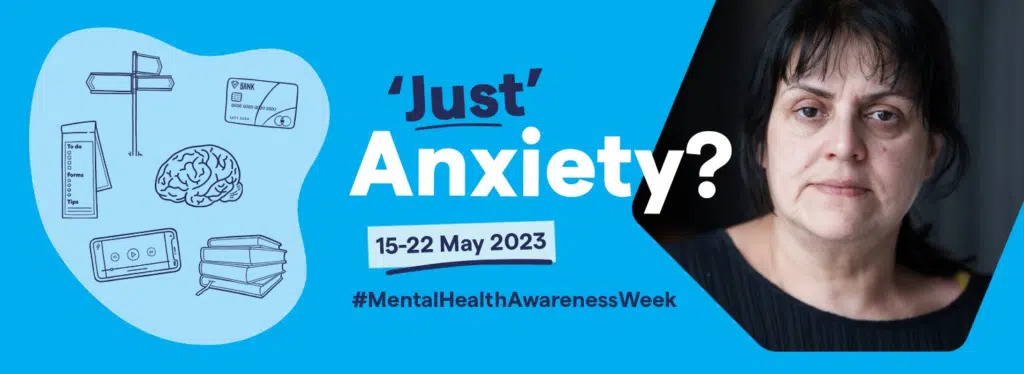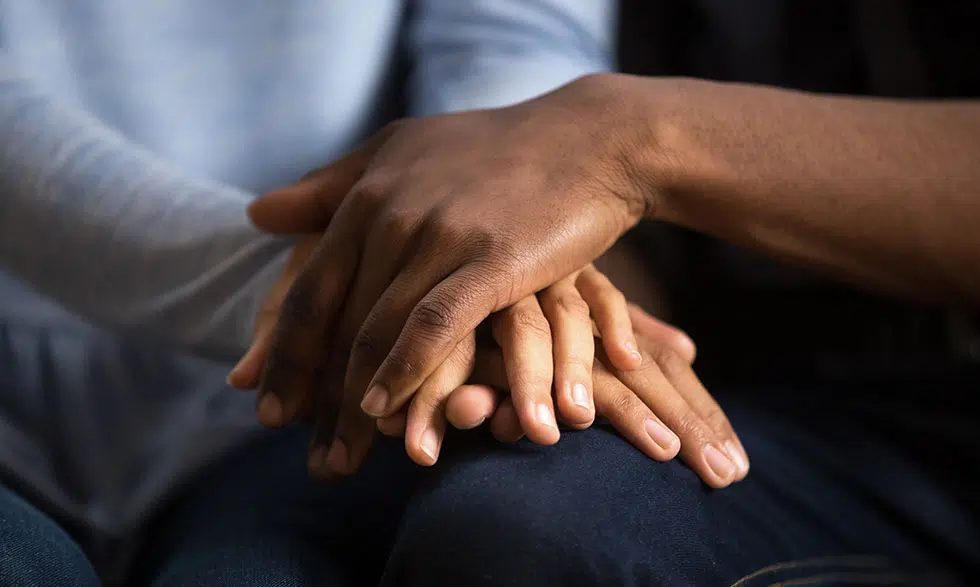This year, the 2023 mental health awareness week takes place from Monday 15 May to Sunday 21 May, focusing on the theme of anxiety.
The campaign aims to increase the awareness and understanding of anxiety in order to demand change.
The campaign ‘just’ anxiety?, seeks to educate about the difference between anxiety and anxiety disorders and encourage people to signpost support to each other.
With anxiety affecting millions of people worldwide, it is crucial to raise awareness and reduce the stigma so that we can support people struggling with anxiety to feel understood and supported.
Anxiety
Anxiety is an extremely common emotion that we all experience at some point in our lives.
For example people may experience anxiety before an exam or interview. During these times, these feelings are completely normal.
However, people with more severe anxiety have more constant feelings of anxiety which affect their daily life.
In the UK, anxiety is one of the most common mental health disorders.
It is a feeling of unease, worry or fear that ranges from mild to severe.
Anxiety can manifest itself through thoughts, feelings or physical sensations, often triggered by worries about the future.
An anxiety disorder happens when your anxiety interferes with your ability to function, you find yourself overreacting when your emotions are triggered and you struggle to control your responses to certain situations.
Whilst anxiety is a normal emotion, for some people, they can struggle to control their worries. This causes their anxiety to affect their daily lives and ability to live as they would like to, impacting their overall mental and physical health.
Anxiety can cause people to socially withdraw, struggle to maintain their work life and make them avoid certain situations or places.
Often, anxiety can cause repeated panic attacks that can be difficult to control.
Many people find it difficult to reach out for support, so they find ways to hide their anxiety so it is unnoticeable.
Anxiety can be triggered by a range of experiences during childhood, adolescence or adulthood.
Someone who has gone through stress and trauma is likely to experience symptoms of anxiety.
Anxiety triggers:
- Exhaustion
- Stress and pressure
- Work problems
- Abuse and neglect
- Family issues
- Bullying and racism
- Health issues
- Financial worries
- Social situations
- Past or childhood experiences
- Drugs and medication
Having a family history of anxiety or mental health conditions can also raise the possibility of someone experiencing an anxiety disorder.
People with a higher risk of developing anxiety often have certain personality traits, such as shyness or behavioural inhibition.
They may struggle to concentrate, be irritable and easily tired.
Anyone can experience mental health disorders, however LGBTQ people, ethnic minority groups, young women aged 16-24 and people with overlapping problems are more likely to experience them than others.
It is important to understand that your identity doesn’t give you mental health problems and the causes of mental health can be very complicated.
Anxiety releases regular stress hormones which is what causes the detrimental effects on people’s long term mental health, if not treated.
It is possible to have more than one anxiety disorder.
Anxiety disorders
Generalised anxiety disorder
It makes you feel anxious and uncontrollably worried about everyday life issues rather than a specific event. People will have difficulty concentrating or relaxing
Social anxiety disorder
It is an intenses fear of social situations and judgement by others. It can cause
regular panic attacks and low self esteem and has no clear cause
Phobias
These can be triggered by a particular situation or object and causes extreme irrational fear or anxiety. People with phobias usually have difficulty functioning and will avoid certain situations
Post traumatic stress disorder
This diagnosis is developed by experiencing a traumatic experience, were they will
get flashbacks, nightmares and severe anxiety
Obsessive compulsive disorder
This involves having repetitive thoughts, behaviours or urges that cause mental discomfort. People with OCD often do not have control over their negative thoughts
Health anxiety
People have obsessions and compulsions related to illness that start to take over their lives. It is related to obsessive compulsive disorder and causes constant worries and need for reassurance in frequent health checks
Body dysmorphic disorder
This involves obsessions and compulsions relating to body image. It causes obsessive worries and repetitive behaviours and routines about the way you look and appear to others
Perinatal anxiety
During pregnancy and after giving birth it is common for mothers to develop anxiety. It can cause constant worrying about a range of issues and physical symptoms like panic attacks
Separation anxiety
This is caused by excessive distress from the thought of being away from loved ones or home. People can experience emotional distress including panic attacks and crying fits
Anxiety feels different to everyone and can affect both physical and mental health.
The symptoms can range from manageable to severe, so it is important to seek necessary treatment.
The most common psychological symptoms of general anxiety include
- Restlessness
- A sense of fear or dread
- Feeling constantly on edge
- Difficulty concentrating
- Irritability
The most common physical symptoms of general anxiety include
- Fast irregular heartbeat
- Shaking or trembling
- Excessive sweating
- Stomach ache or feeling sick
- Headaches
- Muscle aches and tension
- Dizziness and tiredness
- Dry mouth
- Pins and needles
- Difficulty sleeping or concentrating
It is important that if a person’s symptoms begin to become more severe and start affecting daily life, they should contact their GP.
Fortunately, there are several ways to reduce anxiety and manage its symptoms so that it doesn’t impact people’s daily lives.
Managing anxiety
Self care
Prioritising eating well, getting enough sleep and staying active plays a huge role in starting to manage anxiety. Some examples of ways that people can help themselves include: talking to someone you trust, managing worries, looking after physical health, breathing exercises to relax, keeping a diary and reach out for peer support
Medication
A doctor may prescribe medication alongside other treatments to help manage anxiety symptoms both short and long term. Medication can be offered for physical and psychological symptoms and should be reviewed regularly with the doctor to check your progress
Talking therapies
There are three types of treatment recommended to help manage anxiety: cognitive behavioural therapy, applied relaxation therapy and exposure therapy.
Cognitive behavioural therapy focuses on thoughts, beliefs and attitudes and how they affect feelings and behaviour. The therapy aims to teach people how to cope with their problems
Applied relaxation therapy involves learning how to relax muscles when you experience a stressful situation
Exposure therapy gradually exposes the person to their fears or phobias in a safe environment to reduce their fear and decrease avoidance
Limiting alcohol and drug consumption
It is common for people suffering from mental health conditions such as anxiety to turn to alcohol or substances to cope with their stress. However this only suppresses and postpones the difficult emotions and makes it harder to manage the anxiety. Reducing this intake will clear the mind and improve your energy and sleep
Support groups
These groups allow people who are struggling to be able to connect with others, share coping strategies and empower each other. They will often offer education and practical experiences, one to one mentoring and provide vast resources.
Support organisations for anxiety
Anxiety UK
They offer extensive support services to help people take control of their anxiety. They offer: a community, one to one therapy, resources to improve people’s understanding of anxiety, support groups and anxiety courses.
Mind
They provide support and advice to empower people that are experiencing anxiety and mental health problems. They campaign to raise awareness, promote the understanding of and remove the stigmas associated with mental health. Part of their initiatives are to offer specialised support and care based on the needs of the communities.
Rethink mental illness
Their services support both peoples mental and physical health, and aim to ensure they feel a sense of belonging within the community. Some of the support they offer includes: advocacy, carers and community support, advice and helplines, criminal justice, housing, nursing and residential care and employment and training.
It is important to remember that feeling anxious is normal and seeking help is a sign of strength not weakness.
Recovery is a journey and it starts with learning more about yourself and developing ways to cope that are personal to you.
Statistics
In 2022/23 an average of 37.1% (women) and 29.9% (men) reported high levels of anxiety
The most likely age group to experience anxiety are those aged 16-29 whilst the least likely are those aged 70+
In 2023 60% of individuals experienced at east mild symptoms of anxiety
At least 1 in 6 people will be diagnosed with anxiety in any week in England
A quarter of adults said they felt so anxious it stopped them from doing things they wanted to do.
Women are twice as likely to be affected by panic disorders than men
References
Mental Health Awareness Week 2023
Anxiety: statistics | Mental Health Foundation
How common are mental health problems? – Mind
Anxiety Statistics UK | 2023 Data | Champion Health
Overview – Generalised anxiety disorder in adults – NHS
Anxiety and panic attacks – Mind
https://www.myndup.com/blog/mental-health-statistics-2023

https://mentalhealth-uk.org/mental-health-awareness-week/ – Mental health awareness week campaign for 2023 ‘Just’ Anxiety?

https://magazine.medlineplus.gov/article/how-to-help-someone-with-anxiety/ – Supporting someone with anxiety

https://digital.nhs.uk/news/2021/new-statistics-released-on-talking-therapies-in-england – Talking therapy as a treatment to manage anxiety


